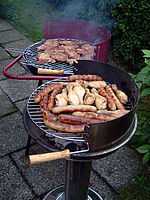Barbacoa
.JPG)
Barbacoa ![]() barba'koa (help·info) is a form of cooking meat that originated in the Caribbean with the Taíno people, from which the term “barbecue” derives.[1] In contemporary Mexico, it generally refers to meats or whole sheep slow-cooked over an open fire, or more traditionally, in a hole dug in the ground covered with maguey leaves, although the interpretation is loose, and in the present day (and in some cases) may refer to meat steamed until tender.
barba'koa (help·info) is a form of cooking meat that originated in the Caribbean with the Taíno people, from which the term “barbecue” derives.[1] In contemporary Mexico, it generally refers to meats or whole sheep slow-cooked over an open fire, or more traditionally, in a hole dug in the ground covered with maguey leaves, although the interpretation is loose, and in the present day (and in some cases) may refer to meat steamed until tender.
Adaptations

In the US, barbacoa is often prepared with parts from the heads of cattle, such as the cheeks. In northern Mexico, it is also sometimes made from beef head, but more often it is prepared from goat meat (cabrito). In central Mexico, the meat of choice is lamb, and in the Yucatan, their traditional version, cochinita pibil (pit-style pork), is prepared with pork.
Barbacoa was later adopted into the cuisine of the southwestern United States by way of Texas, which had formerly been a part of northern Mexico. The word transformed in time to "barbecue",[2] as well as many other words related to ranching and Tex-Mex cowboy or vaquero life. Considered a specialty meat, some meat markets only sell barbacoa on weekends or holidays in certain parts of South Texas and in all of Mexico. Barbacoa is also popular in Florida, as many Mexican immigrants living there have introduced this dish. Barbacoa is also well known in Honduras.
Traditions
A traditional Mexican way of eating barbacoa is having it served on warm corn tortillas with guacamole and salsa for added flavor; the tacos are often served in the banana leaves on which they were cooked, often eaten with onions, diced coriander and a squeeze of lime juice.
Etymology

The Arawak Indian evidence predates all of the later references of the word, which wrongly claim that the word barbacoa comes directly from the mainland Taino Indians, citing the following as a reference that goes into some detail, but cannot account for the Arawak derivation, and never mentions them or the real derivation of barbacoa from the word barbados.
Nonetheless, these claim: "Pero tomemos el vocablo barbacoa, cuyo origen arauco (específicamente, taíno) es conocido gracias a las descripciones de Gonzalo Fernández de Oviedo en su Historia natural y general de las Indias, quien testimonia dos de sus acepciones".[3] "But when we take the term 'barbacoa', which originates from Arauco (specifically, the Taíno language), it is known thanks to the writings of Gonzalo Fernández de Oviedo in his Natural and General History of the Indians, who described two of its meanings."
On the other hand, the derivation of barbacoa from barba(do) is quite straightforward if assumed to be Basque - the language and ethnicity of large numbers of Spanish crew members: barba(do)-ko-a means literally "that(-a) [food] of/from (-ko) [the] barba(do)", a formation totally analogous to that of another well-known Basque dish marmitako(a), "that [food] from [the] marmite [a large metal cooking pot]".
Venues
The large food court of the tianguis (public market) of Chiconcuac in the state of Mexico, outside of Mexico City, seats hundreds of diners who are served barbacoa de borrego (mutton barbecue) and other regional specialties by dozens of open-air restaurants.
Restaurante Arroyo, the world's largest Mexican restaurant, located in the Tlalpan district of Mexico City, is principally famous for its pit-roasted barbacoa de borrego and consomme de borrego, soup made from the drippings of the roasting lamb and sheep. Another little restaurant in Mexico City, La Barbaca de Hidalgo, is famous for pit-roasted barbacoa de borrego a pie de horno with the most traditional flavor.
Across the México-Pachuca highway, many barbacoa stands at the road's side serve drivers. The meat traditionally comes from the outside cheek of cattle.
Chipotle Mexican Grill in the United States, Canada and the UK is also a well-known restaurant that serves beef called "barbacoa".
See also
References
- ↑ The Great American Barbecue and Grilling Manual by Smoky Hale. Abacus Publishing, 2000. ISBN 0-936171-03-0
- ↑ "Barbecue | Define Barbecue at Dictionary.com". Dictionary.reference.com. Archived from the original on 8 April 2010. Retrieved 2010-04-04.
- ↑ "IV CILE. Paneles y ponencias. Eusebio Leal Spengler". Congresosdelalengua.es. Archived from the original on 11 April 2010. Retrieved 2010-04-04.
| ||||||||||||||||||||||||||||||||
